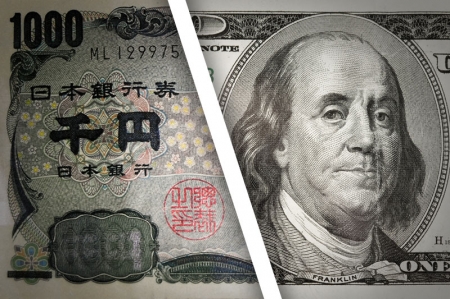
Investing.com– Most Asian currencies drifted lower on Thursday, coming under pressure from a stronger dollar as hawkish comments from the Federal Reserve furthered bets on a slower pace of rate cuts in 2025.
The yen was an outlier, benefiting from increased speculation over an interest rate hike by the Bank of Japan after wage data for November read stronger than expected.
But the yen, like most Asian currencies, was nursing steep losses in recent sessions amid pressure from a stronger dollar and rising U.S. Treasury yields.
Weak inflation data from China also weighed on sentiment, as disinflation remained squarely in play in Asia’s biggest economy, despite recent stimulus efforts from Beijing.
The dollar index and dollar index futures steadied in Asian trade after coming back in sight of over two-year highs on Wednesday.
The minutes of the Fed’s December meeting showed policymakers growing increasingly geared towards a slower pace of rate cuts in 2025. Fed members also expressed some concerns over expansionary policies under President-elect Donald Trump potentially underpinning inflation.
Yen rises as wage data spurs Jan rate hike bets
The Japanese yen firmed on Thursday, with the USDJPY pair falling nearly 0.3% and briefly breaking below 158 yen.
Average cash earnings data read stronger than expected for November as Japanese wages continued to benefit from bumper hikes won earlier in 2024.
The data furthered the notion of a virtuous cycle in Japan’s economy- that increasing wages will underpin inflation and give the Bank of Japan more impetus to hike interest rates sooner, rather than later.
“We believe that recent data – including solid consumption, 2% above inflation for a considerable period, and continued healthy wage growth – support a January hike,” ING analysts said in a note.
BOJ Governor Kazuo Ueda had earlier signaled that the bank would look to wage negotiations in March before deciding on a hike. But ING analysts said the case was building for a January hike, although it would still be a close call.
Chinese yuan weakens on soft inflation
The Chinese yuan weakened on Thursday, remaining close to its softest levels in 17 years. The yuan’s USDCNY pair rose 0.2% and remained well above the psychologically important 7.3 level.
Consumer price index inflation barely grew in December, while producer price index inflation shrank for a 27th consecutive month.
The print showed little improvement in China’s long-running disinflationary trend, and signaled that Beijing will likely have to do more to shore up economic growth.
Broader Asian currencies mostly weakened on Thursday. The Australian dollar’s AUDUSD pair fell 0.1% as data showed retail sales grew less than expected in November, despite support from the Black Friday shopping event.
But Australia’s trade balance grew more than expected in November, on support from strong commodity exports.
The South Korean won’s USDKRW pair fell 0.1%, amid continued efforts to arrest President Yoon Suk Yeol over a failed attempt to impose military law.
The Singapore dollar’s USDSGD pair was flat, while the Indian rupee’s USDINR pair hovered just below the 86 rupee level.
This post is originally published on INVESTING.


